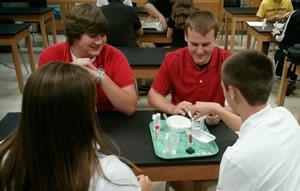I was out for a day last week and left a case study for my anatomy students. The case was about six pages long and starts with a doctor examining a pregnant woman and hearing what he thought was a heart murmur in the fetus. The pages build upon each other, asking students to use Google to look up fetal circulation, draw diagrams, analyze vital signs of the infant and to finally, on the last page provide a diagnosis. This isn’t the first time the class has done a case study, but it was the first time that I wasn’t there to facilitate the process.

When I returned the next day, I asked the students how it went and asked them to turn in their cases; I only needed one per group of 2-3 students. Curiously, many of the students came up to the desk to hand in their cases, but they needed to be stapled. I asked one why they took the staples out in the first place, and he explained that he had done the first 3 pages and his lab partner had done the last three.
I was stunned! This was not how the case was supposed to be completed. They were supposed to work together, discuss the case, come to a conclusion as a group, but instead they had opted for what they considered the most efficient way to complete the assignment. Some confessed that they hadn’t even worked on it in class and had taken their pages home as homework.
I spent a good 5 minutes giving my class a long lecture on collaborative learning and explaining why they had done the project wrong. It was like reading only the first or the last half of a book. Also, the last pages were the hardest, and were unequally weighted as a grade. Most of my students just stared at me with blank faces, not understanding why I was ranting and railing at them.
The incident reminds me why I am very selective with how and why students do group work. As an undergraduate and a first year teacher, I was told that group work was the best way for students to learn. I read many papers on constructivism and cognition and started off with my desks organized into little pods so that students could work together. The methods were supposed to inspire critical thinking, make them better problem solvers and improve overall engagement. Like many first-year teachers, I struggled with classroom management, and it didn’t seem like very much meaningful learning was going on in those groups.
I’ve been a teacher for over twenty years, and now my desks are lined up in rows in a traditional way, and probably 50-60% of my instruction is direct instruction. Group work still has a place, as with case studies, laboratory investigations, and as a way to reinforce difficult topics.
The Spring Issue of American Educator included an article by Tom Bennett titled “Group Work for the Good” which really mirrored some of my sentiments about group work, and offered scathing criticisms about how education research is conducted. How often are we told that we should do things a certain way because the “research” says so? How often do we feel like failures because we just can’t get the same results by doing things that way? New teachers are most at risk for the fad-of-the-year strategies.
The author points out some of the drawbacks of group work, such as:
- Disguised inactivity – some groups members don’t actually do much at all, though pretend to be the one “running the group” or “writing things down”
- Unequal Loading – some members contribute more to the effort
- Inappropriate socialization – students spend most of the time playing
- Unfair assessment – group grades don’t reflect what students have learned
Though Tom Bennett isn’t against all forms of group work, he questions the educational research and suggests that group work has its place, but should not replace direct instruction. His book, titled “Teacher Proof: Why research in education doesn’t mean what it claims, and what you can do about it” has a more in-depth discussion about how research in education is often flawed. I will be putting this one on my summer reading list!

